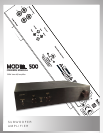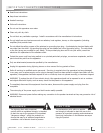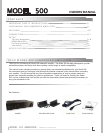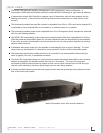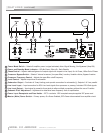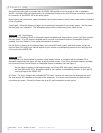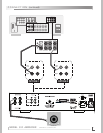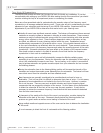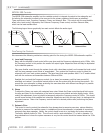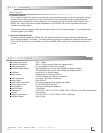
8
O W N E R ’ S M A N U A L
MODEL 500 AMPLIFIER
S E T U P
Tips, Hints, & Suggestions
The MODEL 500 controls will allow you to make the best of virtually any installation. If you feel
uncomfortable with setting up your MODEL 500 after reading through this manual then you should
consider enlisting the help of an experienced person or contacting your dealer.
Below are a few generalized rules for understanding the acoustic nature of low frequency sound
reproduction in an average residential listening room. These rules will aid in understanding the best
placement of your subwoofer and the tuning of your MODEL 500 amplier. Experiment with the
adjustments of your MODEL 500 to determine what works best in your listening room.
Virtually all rooms have signicant resonant modes. The listener will experience these resonant
modes as an acoustic increase or decrease in intensity at certain frequencies. These resonant
modes are a result of reected acoustic energy within the room interacting with other acoustic
energy, either reected or direct. These frequency dependent nodes or antinodes, as they
are called, are different for every listening position within the room. Equalization cannot
simultaneously compensate for all locations within a room. Only physical elements within or
at the room’s boundaries can effectively alter the room’s behavior. These resonant modes can
produce large errors in the frequency response and reduce the overall enjoyment of the audio
reproduction. Subwoofer placement has some effect on the location of the resonant modes.
One should contact an expert in the eld of acoustics if one nds that the low frequency
reproduction in their room is unsatisfactory.
Placing a subwoofer near a wall will substantially increase its effective radiating power,
especially at very low frequencies. Placing the subwoofer near the intersection of two walls (a
corner) will substantially increase it even more. Corner loading, as it is called, is an excellent
way to get bass extension and greater acoustic output from your subwoofer and can increase
the listening pleasure.
Placing the subwoofer close to the listening/sitting position will increase the intensity of the
transients and reduce the acoustic power demands from the subwoofer. The listener will hear
more direct sound from the subwoofer and less reected sound.
Bass frequencies are generally considered to be omnidirectional and tend to have no
localization. That is to say that it is difcult to determine their place of origin. For this reason,
placement of most subwoofers is not limited to the front of the room. However, in practice
this is not the case. There are cues such as tactile vibration and higher frequency signal
components that can suggest the direction of the source. For this reason it may be desirable
to locate the subwoofer at the front of the room near the main speakers. It may also be
necessary to reduce the crossover frequency if one nds that the bass sounds too detached
from the other sound sources.
If placement of the woofer at the front of the room is not an option, consider placing the
subwoofer at the back of the room. Placement directly behind the listening position can
produce very good results as well as corner loading in the back of the room.
Using multiple woofers at opposite corners of the room can be done to balance the localization
of the sound.
It is not necessary to direct the front of a subwoofer at the listening position.



